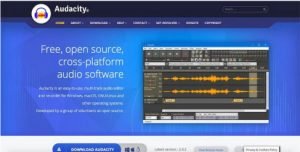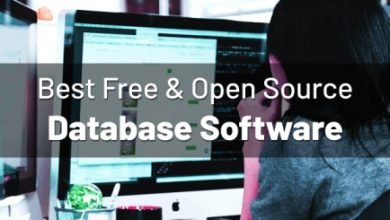Top 10 Best Audio Editing Software For Mac & Windows

Professional audio production has come a long way in the previous ten years. What used to need expensive digital audio workstations (DAWs), audio editing software, and recording equipment may now be achieved with just a laptop and a microphone. Furthermore, audio quality frequently takes precedence over video quality. A unsteady or less-than-perfect visual footage can occasionally be improved with professional audio.
Poor audio, on the other hand, is significantly more noticeable and difficult to fix with a well filmed video. When looking for the best audio editing software, however, there are so many alternatives to choose from that it can be overwhelming. I recall being unable to repair a terrible audio track while working on a video with a friend.
I searched the internet for hours looking for a solution that could simply remove background hums and p-pops. After reviewing tools late into the night, I eventually found what I was looking for. To save you time, I compiled a list of the top 10 audio editing software for Mac and Windows.
The features, cost, ease of use, export options, integrations, and other aspects of these products were considered. This article discusses the finest audio editing software for musicians, film editors, podcasters, and everyone in between.
The Best Audio Editing Software
Here are my top selections for the best audio editing software.
1. Avid Pro Tools

Pro Tools is one of the top audio editing software alternatives for small and large studios looking to connect their hardware with powerful software. Furthermore, Pro Tools features a robust workflow that allows you to simultaneously record up to four microphones.
Its Audio Engine is built on a 64-bit architecture, features a low-latency input buffer, and can dynamically allocate host processor resources. It’s also simple to distribute songs with Pro Tools. It enables you to stream music from Apple Music, Spotify, Amazon Music, iHeartRadio, and more providers.
Here are some of the elements that allow you to create professional-quality sound for movies:
- To make greater mixes, you can use up to 768 voices/audio tracks.
- The hardware includes a dedicated DSP and high-quality audio I/O.
- Routes can be routed in any way you like.
- The ability to locate and collaborate with specialists all over the world.
Pros:
- Multiple metering standards, such as peak and average to VU, K, and PPM, are used to align with local broadcast norms.
- It enables you to compose music as the track is being recorded or entered.
- Avid Nitris DX, Avid Mojo DX, and a range of Blackmagic Design video interfaces are also supported by Pro Tools.
- It also works with AJA to monitor QuickTime and DNxHD video.
- Use the cloud-based collaboration feature to collaborate with up to 10 people on the same project.
- Import sessions created with other audio editing software with ease.
- During the mixing session, the numerous AIR effects come in helpful.
Pricing:
There are two pricing options for Pro Tools:
- Pro Tools costs around $29.99 per user every month (it provides essential tools to compose, record, and mix audio)
- Pro Tools Ultimate costs about $79.99 per user each month (it provides ultimate tools for professional audio editing)
2. Cubase

Steinberg Cubase is a powerful audio editing software for users who want to create, mix, and produce music. When it comes to audio editing, you have a variety of tools at your disposal to help you improve the mixing and quality of your recordings. In addition, a number of adaptive tools aid in the speedier development of music.
It also includes a variety of effects, synthetic instruments, and noises to help you add depth to your audio. Editing and sequencing MIDI and audio is also simple. It has the ability to export and import XML files, which is a benefit. Write, latch, touch, and read modes can all be triggered using the recording automation capability.
To swiftly construct takes, use the Comp Tool’s drag-and-drop interface. It contains 3,400 patches split across eight instruments. Over 80 plugin effects, including EQ, Delay, Reverb, and mastering tools, are accessible. You can arm your audio with fantastic music thanks to Allen Morgan’s 150 track presets.
Pricing:
- A one-time purchase of Cubase costs $329.99.
- You can also upgrade to gain access to additional features.
3. PreSonus Studio One

Studio One is an excellent audio editing program for recording voice and making incredible beats. It’s extremely versatile and responsive. For example, its drag-and-drop interface allows you to easily design instruments with complete pictorial representation. Using the drag-and-drop interface, you may easily complete a range of additional vital tasks, such as:
- Audio loops, virtual instruments, and presets may all be readily dragged into your session.
- Convert MIDI to audio or vice versa by copying FX chains from one channel to another.
- By dragging a plugin into your effects chain, you may eliminate problems.
Aside from that, it has all of the editing features that a good digital audio workstation should have (DAW). Create fades, cut or divide clips, and change the gain of a clip using the ‘Edit’ interface.
Pros:
- It includes a drum editor as well as an acoustic kit.
- It has 64-bit floating-point WAV recording and export capabilities.
- Using the sophisticated group option, you can edit numerous tracks at once.
- Create echoes to constantly vary pitch and delay.
- With its Arranger Track, you can efficiently manage arrangements and chord shuffles.
- External audio can be fed into the Aux Channel.
Pricing:
- A one-time purchase of Studio One costs $449.
- Upgrades are also available for more advanced functionality.
4. Audacity

Audacity is one of the greatest open-source and cross-platform audio editing programs for multi-track editing and audio editing software. It works with macOS, Windows, GNU/Linux, and a range of other operating systems and has a simple interface. A microphone/mixer can also be used to record live audio and digitize sounds from other sources.
Audacity generates high-quality audio in 16-bit, 24-bit, and 32-bit formats. Apart from that, it converts formats and sample rates with high-quality dithering and resampling. Effect plugins such as LADSPA, Nyquist, LV2, VST, and Audio Unit are also supported. If none of these plugins match your requirements, you can create your own.
Pros:
- Its plugin manager is capable of handling a wide range of plugin installations.
- To go back or forward by any number of steps, you can use an endless number of sequential Undo and Redo.
- Export numerous audio files in different formats at the same time.
- Its ‘Level Meter’ keeps track of volume levels in real time or before and after recordings.
- Play around with sample points using the Draw tool.
Pricing:
- It’s a completely free open-source program.
5. Adobe Audition

For broadcasters who want to edit, mix, and recover audio, Adobe Audition is a handy audio editing software. Adobe Creative Cloud includes it (CC). Single-track and multi-track editing are both possible with Adobe Audition. You can also drag and drop files into the timeline, which is a fantastic feature for beginners. It has a simple and modern user interface that allows you to focus on improving your audio recordings.
Pros:
- Its autodocking tool allows you to dynamically change the sound of speech or music.
- Remove hisses, beeps, and background noise by using the Spectral Frequency Display.
- This tool also allows you to graphically edit sound-waves.
- Add your finished audio files directly to video editing software like Adobe Premiere Pro.
- Capture audio from several microphones and mix or modify speech from various speakers with ease.
- Both Multitrack and Waveform editing are available.
- External equipment, such as mixers or audio interfaces, is supported for improved results.
Pricing:
- It provides a seven-day free trial edition.
- Business Class: Each user pays roughly $20.99 per month.
Students and teachers receive discounts. Businesses that require several licences are eligible for further reductions.
6. Ocenaudio

Ocenaudio is a daily-use audio editing software that is simple, quick, and functional. It offers a simple user interface and displays effects in real time, allowing you to get audio editing done quickly. The keyboard shortcuts in Ocenaudio help you edit faster and more efficiently.
Aside from that, it works with both local and cloud-based files. With a single button push, you can access its extensive array of filters for sound manipulation. It also contains a fully completed spectrogram for a more in-depth look at the spectral composition of the music.
Pros:
- Real-time spectrogram adjustments.
- Stacking effects are almost non-existent.
- For new users, the user interface is simple and straightforward.
- Its filters make it simple to achieve the appropriate voice modulation.
- You can save time by simply copying and pasting audio segments.
- For easier organising, you can convert segments of the audio file into designated “regions.”
Pricing:
- It’s open-source software that you can get for free.
7. Ashampoo Music Studio

Ashampoo Music Studio is an excellent music editing program that also includes multimedia features. It allows you to extract audio from videos and CDs directly. You can import entire directories or individual audio songs to create playlists. Its built-in audio editor allows you to quickly cut and chop audio recordings to your liking. Aside from that, the editor has the ability to adjust the volume, separate tracks, and so forth.
Pros:
- Automatically rename a few tracks or an entire folder to bring structure to your disorganized playlist.
- Volumes can be adjusted in parts of audio files.
- You can also turn off the audio for the entire segment.
- You can save your final audio file wherever you choose.
- At the same time, record audio files from several sources.
- It also has the ability to convert audio files into a variety of other formats.
- The architecture is compatible with both 32 and 64-bit platforms.
Pricing:
- The premium version will set you back $29.99 per user.
- It also provides a free trial version of its full-featured software.
8. Reaper

Reaper is an excellent digital audio generating application for beginners looking for a low-cost option. It supports a large number of digital formats, plugins, and hardware. The software can also be tweaked, edited, or expanded as needed. Another benefit is that it is a well-coded audio editing software that is both stable and simple to use.
Audio and MIDI routing, as well as powerful multi-channel capabilities, are included. The team also releases regular updates that include new features, bug fixes, and feature enhancements. Other prominent features include automation, grouping, modulation, VCA, macros, surround, OSC, control surfaces, scripting, and custom skins.
Pros:
- Enable the loop while ignoring the note-off.
- You can personalise the menu and controls to suit your needs.
- The envelope control panel assists you in avoiding any possible hangs.
- It works with over 20 different audio formats.
- It supports a variety of file types, including MP3, WAV, and AIFF.
- Reaper also allows you to overdub a video file because it supports all common video formats.
Pricing:
It has two licenced plans to choose from:
- Licensing at a discount-$60 per licence
- Commercial licences are $225 each.
Individuals or enterprises with a yearly gross turnover of less than USD 20,00 are eligible for the discounted licensing version.
9. Sound Forge Audio Studio

For all of your digital audio editing needs, Sound Forge is a wonderful audio editing software. Thanks to its broad variety of functions and tools, you may edit your audios with professional effects. It also converts cassettes and vinyl records to digital audio. You may also create video soundtracks as well as burn and manufacture CDs.
It also adds sound 11 effects from the DirectX plugin to add a professional touch to your audio recording. You can also see how the effects will look before using them in your final video. Sound Forge also has the advantage of being completely configurable in terms of its toolbar and interface, allowing you to create your own audio editing experience.
Pros:
- Its automatic master wizards allow you to create professional-quality recordings.
- The user interface is fully customisable, with four different shades to choose from.
- For a comprehensive overview of all the tools, use the Instant Action window.
- It will allow you to concentrate on editing and save you a lot of time.
- Install a wide choice of chorus, flanger, and creative effects plugins with the quickFX tool.
- You can simultaneously edit 6 channels of audio.
- Use the Analog Delay function to change an instrument’s delay time.
- You may obtain the desired voice modulation by using its numerous filters.
Pricing:
- Its one-time purchase pricing start at about $59.99.
- You can also try it out for free.
10. Sound Forge Audio Cleaning Lab

Sound Forge is an excellent audio editing programme for repairing audio recordings and digitising vinyl LPs. It offers a simple method for repairing, cleaning, and digitising old audio recordings. This application makes enhancing audio from cassettes, records, audio, and recordings a breeze. It also comes with a sophisticated 1-click solution as well as a large number of presets.
The corrected audio file can also be exported in a variety of formats, including WAV, OGG, MP3, and FLAC. You may clean up the sound with a number of advanced audio settings with just a click. You’ll also get access to a cutting-edge algorithm for changing the pitch and tempo of your audio. Furthermore, the Auto Cleaning option handles the majority of the audio enhancement automatically.
Pros:
- Its 96 kHz/24-bit resolution allows for high-quality voice audio.
- It has over 360 presets to assist you in getting the best sound possible.
- Its user manual contains all of the necessary tips and tricks for using the software.
- RX 7 Elements’ De-hum module automatically detects the fundamental frequency of undesired background noise such as humming.
- During vocal recordings, use the Voice De-Noise tool to eliminate undesired noises.
- You can also rapidly restore a damaged recording.
Pricing:
- The paid version will set you back approximately $100 per user.
- Audio editing software also offers a risk-free trial.




